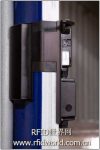
Coscon uses Savi tags to monitor container shipments
[ad_1]
Coscon Logistics, a sister company of Cosco Container Lines Co. (Coscon), is now using the new active tags and SaviTrak software platform provided by Savi Networks to track the location and status of cargo containers when they are shipped from China to all over the world.
Each tag contains a GPS receiver and several sensors to track the location of the tag, the temperature and humidity inside the container, and the time when the door is opened. When the tag is within the signal range of the GPRS/GSM cellular base station, the tag sends its position and sensor data to a back-end system, and Coscon customers (transporters of labeled cargo containers) can log in to the system to obtain information. The GPRS transmitter of each tag contains a SIM card for global roaming, and 4 RF frequency band options (850, 900, 1800, and 1900 MHz). Savi Networks also provides another tag, in addition to the 4 GSM frequency bands, there is also a 2100 MHz option, dedicated to South Korea and Japan.
Coscon is a third-party transportation company that transports consumer products and other goods from China to the rest of the world. The company’s SaviTrak system provides customers with real-time information on location and status via the Internet, and charges a certain service fee. If the customer does not need this service, then their containers will not be labeled, and the transporter will not be able to understand the location and status of the cargo.

A Savi label clipped to the container door
Savi Network provides Coscon customers with labels and system access, and charges service fees. Savi Networks is not only responsible for sending the labels, but also for transporting the used labels to the next location for reuse.
“Our customers can now get real-time information and location of goods during transportation,” said Lin Hongbing, general manager of Coscon Logistics. “For us, collecting environmental data in containers, such as temperature and humidity, has become very easy.”
According to the different needs of Coscon customers, Savi Networks provides two kinds of labels-LS and LSE. LS contains a GPS receiver and security sensor to detect the opening time of the door. In addition to providing location and safety data, LSE also provides temperature and humidity data. The label is manufactured by an unnamed third party.

Another type of label is inserted on the container door
When the customer orders this set of services, the tag is installed on the customer’s container, and Coscon employees then correspond the unique identifier of the tag with the container number, description, order number, destination and expected arrival time. Coscon stores this information, and corporate customers log in to a SaviTrak website with a password to obtain relevant information.
When the tag receives the signal from the GPRS base station, it sends its unique identifier and sensor data. If the container is not within the signal range of the base station for a period of time (such as going to sea), the historical data of the sensor is also included.
“Customers can easily understand cargo information,” Lin said.When a customer logs in, the system can not only provide cargo data, but if there is a change in the environment (such as a temperature rise exceeding a preset threshold) or a security violation (such as an unregulated opening time of the box door), the system will send an alert to the customer and Coscon at the same time
Lin said that Coscon chose the Savi Networks solution because it is easy to operate and the cost is lower than other wireless systems.
Savi Networks also provides another set of solutions, which uses 433 MHz RFID tags that comply with the ISO 18000-7 standard to communicate with RFID readers. However, the company’s senior deputy director Steve Sewell explained that the reason why Coscon chose to be based on the GPRS system was to save the cost of installing RFID facilities in ports around the world. With GPRS, tags can be read in almost all ports in the world.
The SIM card of the tag can be read by any GPRS/GSM base station in the world, at a frequency set by the customer. When the tag is not within the signal range of the base station, the tag will always store the sensor data and GPS position coordinates. When the container enters the signal range of a cellular base station, all the information will be uploaded. If the container has experienced safety violations or temperature problems, the tags entering the signal range will also immediately send an alert to inform the user when and where the incident occurred.
Coscon users who use this system today include transporters of high-value or high-risk products, such as hazardous chemicals, electronic equipment, medicines, or fresh products. Finally, Lin hopes that the Savi Networks system can speed up the customs clearance of containers in Europe or other regions.
At present, the European Union is studying the establishment of a smart and safe trade channel. If this trade channel is completed, the SaviTrak system can speed up the customs clearance process.
[ad_2]



